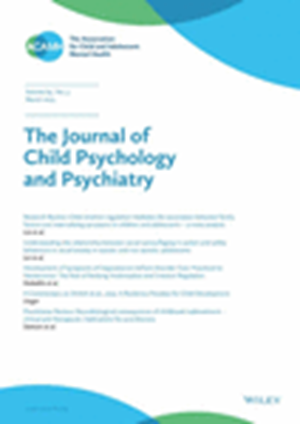Distinct cascades for secure and insecure infants from early anger dysregulation to mothers' and fathers' power-assertive control at toddler age to externalizing outcomes at preschool age: a replication.
IF 7
1区 医学
Q1 PSYCHIATRY
引用次数: 0
Abstract
BACKGROUND Bowlby's concept of attachment as a biobehavioral proximity-regulating system providing infants with confidence in protection and support for exploration has been expanded to include early security's legacy for socialization processes. We report a continued programmatic effort to replicate our model of security as a potent catalyst moderating common maladaptive longitudinal cascades from early child difficulty to increased parental power assertion to externalizing developmental outcomes. We elucidate the multifinality of sequelae that can unfold from early child difficulty. Our moderated mediation model proposes that such cascades occur only in parent-child dyads with histories of insecure attachment in infancy; early security buffers those risks. METHODS Children and Parents Study (CAPS) included 200 community mothers, fathers, and children from the U.S. Midwest. At 16 months (N = 194, 93 girls), we observed children's early difficulty (anger dysregulation) and security with each parent in the Strange Situation Paradigm. At 38 months (age 3, N = 175, 86 girls), we observed parents' power-assertive control. At 52 months (age 4.5, N = 177, 86 girls), we observed children's poor self-regulation and violations of conduct rules and obtained parents' reports of children's disruptive behavior. RESULTS For mothers and children, the indirect effects of early anger dysregulation at 16 months on all three outcomes at age 4.5, mediated via increased power assertion at age 3, were present only in insecure dyads, as reflected in significant moderated mediation. Comprehensive analysis that integrated all three outcomes further supported the robust moderating effect of early security for the entire developmental path from anger dysregulation to power assertion to child outcomes, and for each segment of that path. There were no findings for fathers. CONCLUSIONS We discuss the critical importance - and challenges - of replicating models of complex longitudinal cascades when elucidating multifinality throughthe lens unique to developmental psychology and psychopathology.从早期的愤怒失调到幼儿时期父母的权力自信控制再到学龄前的外化结果,安全型和不安全型婴儿的明显级联:一个复制。
bowlby的依恋概念是一种生物行为接近调节系统,为婴儿提供保护和探索支持的信心,已经扩展到包括社会化过程的早期安全遗产。我们报告了一项持续的计划努力,以复制我们的安全模型,将其作为一种有效的催化剂,缓和从儿童早期困难到父母权力主张增加到外化发展结果的常见的纵向级联反应。我们阐明了从儿童早期困难开始的后遗症的多终性。我们的调节中介模型表明,这种级联仅发生在婴儿期有不安全依恋史的亲子二联体;早期的安全性可以缓冲这些风险。方法儿童与家长研究(CAPS)包括来自美国中西部地区的200名社区母亲、父亲和儿童。在16个月时(N = 194, 93名女孩),我们观察了儿童在陌生情境范式下的早期困难(愤怒失调)和与父母的安全感。在38个月时(3岁,N = 175, 86名女孩),我们观察了父母的权力-自信控制。在52个月时(4.5岁,N = 177, 86名女孩),我们观察到儿童自我调节能力差,违反行为规则,并获得家长对儿童破坏性行为的报告。结果对于母亲和儿童来说,16个月时早期愤怒失调对4.5岁时所有三个结果的间接影响,通过3岁时权力主张的增加来中介,只存在于不安全的二人组中,这反映在显著的调节中介中。综合所有三个结果的综合分析进一步支持了早期安全对从愤怒失调到权力主张到儿童结局的整个发展路径以及该路径的每个部分的强大调节作用。没有针对父亲的调查结果。结论:我们讨论了通过发展心理学和精神病理学的独特视角来阐明多重性时,复制复杂纵向级联模型的重要性和挑战。
本文章由计算机程序翻译,如有差异,请以英文原文为准。
求助全文
约1分钟内获得全文
求助全文
来源期刊
CiteScore
13.80
自引率
5.30%
发文量
169
审稿时长
1 months
期刊介绍:
The Journal of Child Psychology and Psychiatry (JCPP) is a highly regarded international publication that focuses on the fields of child and adolescent psychology and psychiatry. It is recognized for publishing top-tier, clinically relevant research across various disciplines related to these areas. JCPP has a broad global readership and covers a diverse range of topics, including:
Epidemiology: Studies on the prevalence and distribution of mental health issues in children and adolescents.
Diagnosis: Research on the identification and classification of childhood disorders.
Treatments: Psychotherapeutic and psychopharmacological interventions for child and adolescent mental health.
Behavior and Cognition: Studies on the behavioral and cognitive aspects of childhood disorders.
Neuroscience and Neurobiology: Research on the neural and biological underpinnings of child mental health.
Genetics: Genetic factors contributing to the development of childhood disorders.
JCPP serves as a platform for integrating empirical research, clinical studies, and high-quality reviews from diverse perspectives, theoretical viewpoints, and disciplines. This interdisciplinary approach is a key feature of the journal, as it fosters a comprehensive understanding of child and adolescent mental health.
The Journal of Child Psychology and Psychiatry is published 12 times a year and is affiliated with the Association for Child and Adolescent Mental Health (ACAMH), which supports the journal's mission to advance knowledge and practice in the field of child and adolescent mental health.

 求助内容:
求助内容: 应助结果提醒方式:
应助结果提醒方式:


